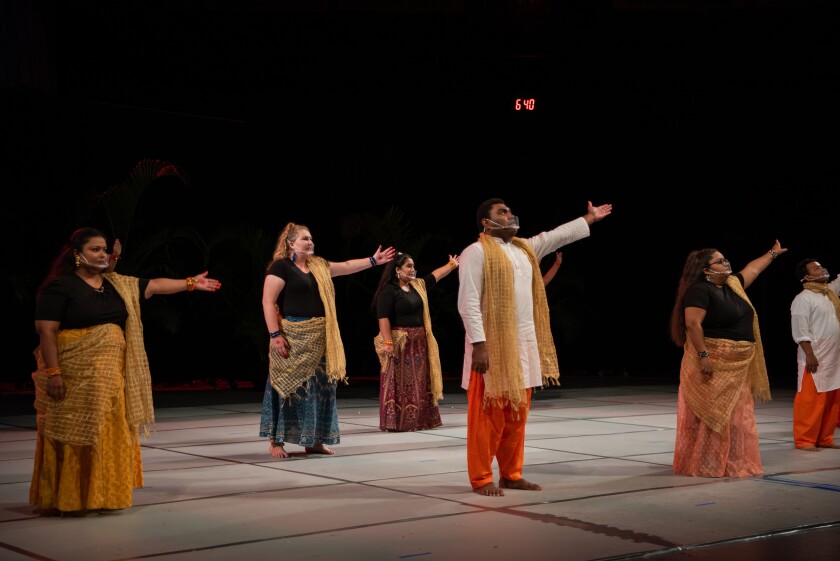
Rajkumar Tamang, a senior from Kathmandu, Nepal, studying social work, is the secretary of the Great India Club. He said culture and music brings people together. “When there is music going on, it doesn’t matter which country is playing it. We all like to listen to it, to dance with it and to have fun. ... I think I saw that. … [It] brought all of us together,” he said.
India Club President Vidya Irene Purushottam, Tamang’s wife and a senior from New Delhi majoring in TESOL education, said the club decided to use the costumes and dances they had prepared for last year’s canceled Culture Night, which were ordered from India. Purushottam said most people assume Indian dances are mostly Bollywood style, so this year they decided to perform different dances from the four corners of India: three folk dances and one classical dance.
Rimpy Vinay Jurial, from New Delhi, India, said she joined Culture Night this year because she is very attached to her culture and performing makes her feel closer to her country. It is also a way for her to show respect to her culture, she added.
Enjoying the journey
Indian folk dances are comparable to Polynesian dances because they both can tell a historical story, Jurial explained. She said many classical dances come from Hindu scriptures or mythology, which allude to the lifespan or journey of a goddess or a god, she shared.
She also said every hand gesture has a meaning, just like in the Hawaiian hula dance.
Purushottam said the names of the dances are Bhangra from the north, Bihu from the east, Dandiya Raas from the west and Kathak from the south. The club also included Bollywood music because they wanted their performance to be pepped up. Nonetheless, their choreography leans towards these folk dances.
Purushottam said their Culture Night practices were focused on “sharing [their] culture, meeting new people and making friends.” Ultimately, she said they wanted to find joy in the journey rather than focusing only on the performance.

She said she knew the pandemic often brings uncertainty and there was a possibility they might not have been able to perform. They coped with this possibility, she added, by focusing on what they had control over.
Her club does not regret taking part in the Culture Night, Purushottam said. “This is one of those [life] experiences where you remember… the journey is usually more important than just reaching the destination.”
Culture Night preparations
Purushottam said their presidency kept their club operating throughout the pandemic because social connection is something people missed the most.
“One way to stay connected would be through the clubs, and so we decided to stay active with [our] club,” she noted.
In the Great India Club, they not only have performers from India but also from places like Tonga and Samoa, she said. For her, Culture Night is such a unique experience because students get to meet other people at the club they choose to participate in for the event.
She said the club members were careful to follow COVID-19 safety protocol. “[It] took a lot of extra effort to make sure people were tested at the right time so they could practice [the following] week,” she said.
“It’s amazing the school allowed us to have Culture Night in the first place [because] you know things are still a little dicey. So we didn’t want to do anything to undo that,” she added.
Purushottam said they are grateful to the Club Leadership Team for doing a commendable job in making sure the club is safe during their practices and the people joining them are tested. “It would have been so much harder if we had to do everything by ourselves,” she shared.
Tamang said in years past, up to 85 people would dance with their club, and this year they had about 20. He said he definitely missed the people who couldn’t practice and perform with them at Culture Night.

Jurial said her favorite dance they performed this year is called Kathak. It comes from the south area of India. Because she is from the north area, she did not get the chance to learn and perform it even though she saw the dance in movies and photos and read about it. “So, this is such a great opportunity for me to learn the dance from the south of my own country,” she said.
Jurial said she loved to represent her culture in Culture Night because she could post photos on Facebook to show her friends how respectful she is with her culture.
Additionally, she said she does not have the chance to attend classes and meet others because she is the spouse of a student. Thus, participating in Culture Night was special to her because she got to know other people.
Meaning behind the costumes
“One thing that is common for most of our folk dances is the vibrancy of the costumes,” said Purushottam. An example of this is the clicking bells they used in Kathak, she explained. Their costumes also included auspicious hand paintings that are common in India.
The men in their performance wore Indian-styled pants, called salwar and long shirts, called kurta, she said. The women wore skirts, called ghagra, black T-shirts and gold Indian-styled scarves, called dupatta.
“Gold is considered God in Hindu religion,” Purushottam elaborated. “[The color gold] is significant in festivals and classical dances.”
Tamang said he is very happy with the way their practices went because his wife made the steps simple but still in line with the traditional culture.
See more photos on Ke Alaka'i's Facebook page.
